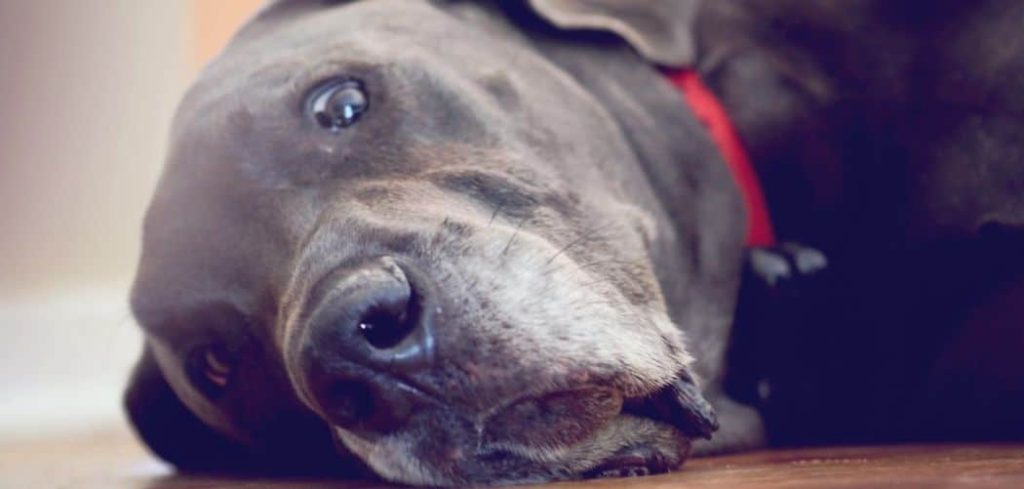It can be worrying to see your dog panting and shaking after a spay surgery.
While some level of discomfort or anxiety is expected during recovery, these symptoms can sometimes indicate pain, or complications that need attention.
We outline the common causes of a dog panting and shaking after being spayed, what you can do at home, and when to seek veterinary help.
Table of Contents
Dog Panting and Shaking After Spay — Why It Happens
Dog panting and shaking after being spayed can be caused by post-surgical pain, medication side effects, anxiety, or complications such as infection. The surgery itself is a major event for your dog’s body, and recovery involves both physical healing and stress management.
Some dogs may react to anesthesia, while others may struggle with inflammation or low blood pressure during recovery.
Environmental stressors, temperature changes, and underlying health issues can also make these symptoms worse.

Common Causes of Dog Panting and Shaking After Being Spayed
Post-Surgical Pain
After a spay, your dog may experience discomfort around the incision site and internally where tissues were operated on.
Pain can cause faster breathing and trembling as the body reacts to discomfort.
You may notice your dog reluctant to move, licking the incision site, or whining. Adequate pain management prescribed by your vet is essential to prevent unnecessary suffering.
Related: Dog panting excessively (Causes and What To Do)
Reaction to Anesthesia
Anesthesia can linger in the system for hours to days after surgery.
Some dogs react with shivering, panting, or appearing disoriented as their body metabolizes the drugs.
These effects usually fade within 24 hours, but persistent or worsening symptoms could indicate an issue that needs a vet’s review.
Medication Side Effects
Pain relievers or antibiotics given after surgery can sometimes cause panting or trembling as side effects.
NSAIDs and opioids may affect breathing rate, while certain antibiotics can cause mild shaking.
If your dog’s symptoms started after medication was given, your vet can determine whether a change is necessary.
Anxiety and Stress
Being at the vet, undergoing surgery, and returning home with discomfort can all be stressful.
An anxious dog may pant heavily and tremble, especially in unfamiliar or noisy environments.
Comfort, gentle reassurance, and a calm environment can help ease these emotional responses.
Infection or Inflammation
If bacteria enter the incision site, your dog could develop an infection that triggers pain, fever, and shaking.
Panting may occur as the body fights inflammation and elevated temperature.
Signs include redness, swelling, heat, discharge from the incision, and loss of appetite. This requires prompt veterinary care.
Low Blood Sugar (Hypoglycemia)
Small breed dogs or those that refused to eat before or after surgery may experience a drop in blood sugar.
This can cause weakness, trembling, and rapid breathing.
Feeding small, frequent meals during recovery can help prevent hypoglycemia, but severe cases need immediate veterinary treatment.
What to Do If Your Dog Is Panting and Shaking After Spay
First, ensure your dog is in a quiet, comfortable space away from other pets or loud noises.
Offer fresh water and encourage rest without forcing movement.
Follow your vet’s post-surgery instructions exactly, especially regarding medication timing and dosages.
Check the incision site twice daily for redness, swelling, or discharge.
If your dog seems very uncomfortable, call your vet to discuss whether pain management needs adjusting.
When to Call or Visit Your Vet
Seek veterinary help immediately if panting and shaking are severe, continuous, or paired with signs like pale gums, vomiting, collapse, or refusal to eat or drink.
Contact your vet if the incision shows redness, swelling, or discharge, or if your dog seems lethargic or confused.
Any sudden worsening of symptoms during recovery should be treated as urgent.
Read more: Dog Panting and Shaking After Giving Birth (Here’s why)
Key Takeaway
Panting and shaking after a spay is often part of the body’s healing process, but it can also signal pain or complications.
Monitor your dog closely, follow your vet’s aftercare instructions, and don’t hesitate to call for advice if anything seems unusual.
With attentive care and prompt action, your dog can recover smoothly and return to their happy, healthy self.
